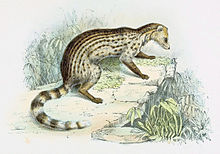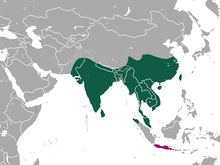Small Indian civet: Difference between revisions
BhagyaMani (talk | contribs) m →Taxobox: corr binomial_authority |
BhagyaMani (talk | contribs) →Distribution and habitat: extended with ref |
||
| Line 33: | Line 33: | ||
Small Indian civets have been recorded in semi-[[Evergreen forest|evergreen]] and [[deciduous forest]], mixed deciduous forest, [[bamboo]] forest, scrubby areas, grasslands and riverine habitat.<ref name=Duckworth1997>Duckworth, J. W. (1997). ''Small carnivores in Laos: a status review with notes on ecology, behaviour and conservation''. [http://www.smallcarnivoreconservation.org/sccwiki/images/2/23/Number_16_%28Apr_1997%29.PDF Small Carnivore Conservation 16]: 1–21.</ref><ref name= Mudappa2002>Mudappa, D. (2002). ''Observations of small carnivores in the Kalakad-Mundanthurai Tiger Reserve, Western Ghats, India''. [http://www.smallcarnivoreconservation.org/sccwiki/images/8/8b/SCC_27.pdf Small Carnivore Conservation 27]: 4–5.</ref><ref name=SuSu05/> |
Small Indian civets have been recorded in semi-[[Evergreen forest|evergreen]] and [[deciduous forest]], mixed deciduous forest, [[bamboo]] forest, scrubby areas, grasslands and riverine habitat.<ref name=Duckworth1997>Duckworth, J. W. (1997). ''Small carnivores in Laos: a status review with notes on ecology, behaviour and conservation''. [http://www.smallcarnivoreconservation.org/sccwiki/images/2/23/Number_16_%28Apr_1997%29.PDF Small Carnivore Conservation 16]: 1–21.</ref><ref name= Mudappa2002>Mudappa, D. (2002). ''Observations of small carnivores in the Kalakad-Mundanthurai Tiger Reserve, Western Ghats, India''. [http://www.smallcarnivoreconservation.org/sccwiki/images/8/8b/SCC_27.pdf Small Carnivore Conservation 27]: 4–5.</ref><ref name=SuSu05/> |
||
===Distribution of subspecies=== |
|||
* ''V. i. indica'' (Geoffroy Saint-Hilaire, 1803) — is distributed in [[Southern India]] from the [[Western Ghats|Western]] to the [[Eastern Ghats]] and as far north as [[Lake Chilka]] on the east coast;<ref name=Pocock1939>Pocock, R. I. (1939). [http://www.archive.org/stream/PocockMammalia1/pocock1#page/n445/mode/2up ''Genus Viverricula Hodgson.''] Pages 362–376 in: ''The fauna of British India, including Ceylon and Burma. Mammalia. – Volume 1''Taylor and Francis, London.</ref> |
|||
* ''V. i. bengalensis'' ([[John Edward Gray|Gray]], 1832) — lives in the plains of [[Northern India]], south of the [[Ganges]], from [[Calcutta]] to [[Gujerat]], and possibly [[Sind Province (1936–1955)|Sind]];<ref name=Pocock1939/> |
|||
* ''V. i. deserti'' ([[J. Lewis Bonhote|Bonhote]], 1898) — was described from [[Rajputana]];<ref name=Pocock1939/> |
|||
* ''V. i. thai'' ([[Cecil Boden Kloss|Kloss]], 1919) — is distributed in Thailand, [[Indochina]], and Myanmar;<ref name=Pocock1939/> |
|||
* ''V. i. mayori'' ([[Reginald Innes Pocock|Pocock]], 1933) — is distributed in Sri Lanka;<ref name=Pocock1939/> |
|||
* ''V. i. wellsi'' (Pocock, 1933) — is distributed in [[Kangra]], [[Kumaun]], and the [[United Provinces of British India|United Provinces]];<ref name=Pocock1939/> |
|||
* ''V. i. baptistæ'' (Pocock, 1933) — ranges from Bhutan and Upper Bengal to [[Assam]].<ref name=Pocock1939/> |
|||
== Ecology and behavior == |
== Ecology and behavior == |
||
Revision as of 15:31, 10 March 2013
| Small Indian civet | |
|---|---|

| |
| Scientific classification | |
| Kingdom: | |
| Phylum: | |
| Class: | |
| Order: | |
| Family: | |
| Subfamily: | |
| Genus: | Viverricula Hodgson, 1838
|
| Species: | V. indica
|
| Binomial name | |
| Viverricula indica Geoffroy Saint-Hilaire, 1803
| |

| |
| Small Indian civet range (green - extant, pink - probably extant) | |
The small Indian civet (Viverricula indica) is a civet found in South and Southeast Asia. It is listed as Least Concern by IUCN because of its widespread geographical distribution, widespread habitat use and healthy populations living in agricultural and secondary landscapes of many range states.[1]
The small Indian civet is a monotypic genus.[2]
It is also called rasse. The Assamese name johamaal refers to its glandular odour similar to a scented rice variety called joha. The species has been introduced to Madagascar.
Characteristics
The small Indian civet is 21 to 23 in (53 to 58 cm) in head and body size and has a rather coarse fur that is brownish grey to pale yellowish brown, with usually several longitudinal black or brown bands on the back and longitudinal rows of spots on the sides. In some specimens both lines and spots are indistinct, and the dorsal bands are occasionally wanting. Usually there are five or six distinct bands on the back and four or five rows of spots on each side. The neck markings are rather variable. Generally there are two dark stripes from behind the ear to the shoulders, and often a third in front, crossing the throat. The underfur is brown or grey, often grey on the upper parts of the body and brown on the lower. The grey hairs on the upper parts are often tipped with black. The head is grey or brownish grey, the chin often brown. The ears are short and rounded with a dusky mark behind each ear, and one in front of each eye. The feet are brown or black. The tapering tail is 15 to 17 in (38 to 43 cm) long with alternating black and whitish rings, seven to nine of each colour.[2]
Distribution and habitat
Small Indian civets are known to occur in south and central China, Hong Kong, most of India, Lao PDR, Myanmar, Thailand, Viet Nam, Cambodia and Sri Lanka. No search has been made for recent records from Nepal, Bhutan, Bangladesh, Peninsular Malaysia, Java or Bali, areas where they were historically recorded. Their current status in Singapore is unclear.[1]
Small Indian civets have been recorded in semi-evergreen and deciduous forest, mixed deciduous forest, bamboo forest, scrubby areas, grasslands and riverine habitat.[3][4][5]
Distribution of subspecies
- V. i. indica (Geoffroy Saint-Hilaire, 1803) — is distributed in Southern India from the Western to the Eastern Ghats and as far north as Lake Chilka on the east coast;[6]
- V. i. bengalensis (Gray, 1832) — lives in the plains of Northern India, south of the Ganges, from Calcutta to Gujerat, and possibly Sind;[6]
- V. i. deserti (Bonhote, 1898) — was described from Rajputana;[6]
- V. i. thai (Kloss, 1919) — is distributed in Thailand, Indochina, and Myanmar;[6]
- V. i. mayori (Pocock, 1933) — is distributed in Sri Lanka;[6]
- V. i. wellsi (Pocock, 1933) — is distributed in Kangra, Kumaun, and the United Provinces;[6]
- V. i. baptistæ (Pocock, 1933) — ranges from Bhutan and Upper Bengal to Assam.[6]
Ecology and behavior
Small Indian civets are nocturnal, mostly terrestrial and insectivorous.[4] They inhabit holes in the ground, under rocks or in thick bush.[2]
Diet
They feed on rats, mice, birds, snakes, fruit, roots and carrion.[7] Occasionally they carry off poultry.[2][5]
Reproduction
The female has usually four or five young at a birth.[2] The life span is eight to nine years.[7]
Threats
People of Traspur village in Assam hunt it for meat and purify its skin into medicine.[citation needed]
Conservation
Viverricula indica is listed on CITES Appendix III.[1] In Myanmar, it is totally protected under the Wildlife Act of 1994.[5]
References
- ^ a b c d Template:IUCN
- ^ a b c d e Blanford, W. T. (1888–91). Genus Viverricula Hodgson. Pages 100–101 in: The fauna of British India, including Ceylon and Burma. Mammalia. Taylor and Francis, London.
- ^ Duckworth, J. W. (1997). Small carnivores in Laos: a status review with notes on ecology, behaviour and conservation. Small Carnivore Conservation 16: 1–21.
- ^ a b Mudappa, D. (2002). Observations of small carnivores in the Kalakad-Mundanthurai Tiger Reserve, Western Ghats, India. Small Carnivore Conservation 27: 4–5.
- ^ a b c Su Su. (2005). Small carnivores and their threats in Hlawga Wildlife Park, Myanmar. Small Carnivore Conservation 33: 6–13.
- ^ a b c d e f g Pocock, R. I. (1939). Genus Viverricula Hodgson. Pages 362–376 in: The fauna of British India, including Ceylon and Burma. Mammalia. – Volume 1Taylor and Francis, London.
- ^ a b Lekalul, B. and McNeely, J. A. (1977). Mammals of Thailand. Association for the Conservation of Wildlife, Bangkok.
External links
- PHOTO SMALL INDIAN CIVET
- Raising Small Indian civet (Viverricula indica) website www.vietlinh.vn
- Fact file from Pensacola Junior College
- Small Indian Civet roadkill, Commons
- IUCN Red List least concern species
- Viverrids
- Mammals of Asia
- Mammals of Bangladesh
- Mammals of Burma
- Mammals of Cambodia
- Mammals of China
- Mammals of India
- Mammals of Indonesia
- Mammals of Laos
- Carnivora of Malaysia
- Mammals of Nepal
- Mammals of Pakistan
- Mammals of Southeast Asia
- Mammals of Sri Lanka
- Mammals of Taiwan
- Mammals of Thailand
- Mammals of Vietnam
- Urban animals
- Monotypic mammal genera
- Animals described in 1804
- Carnivora stubs

